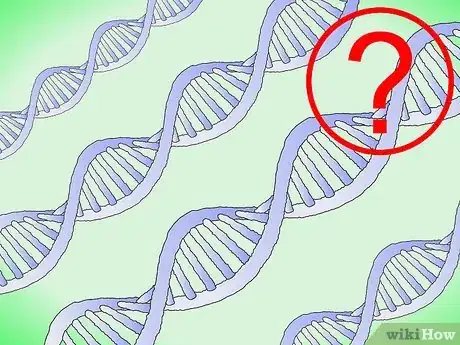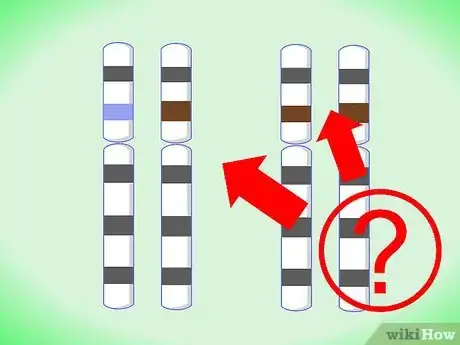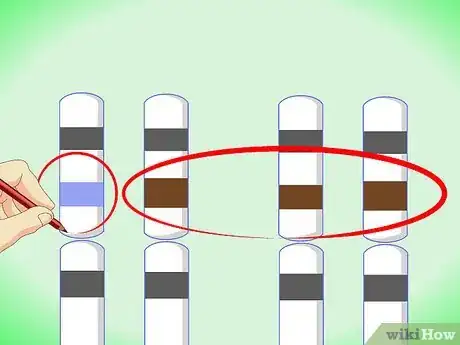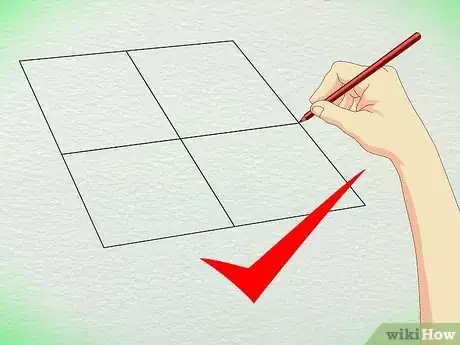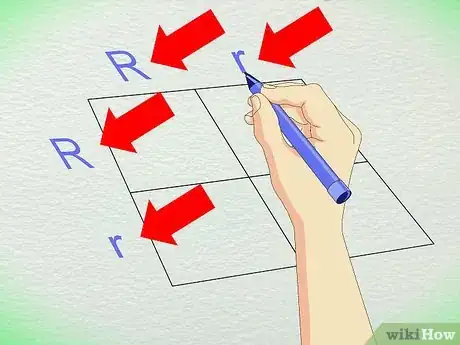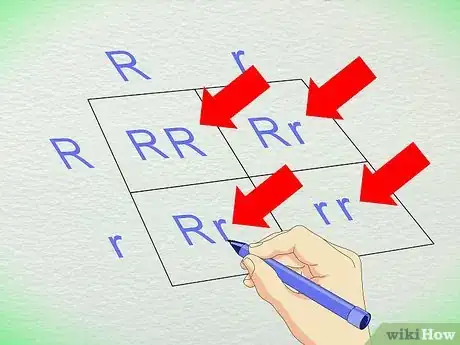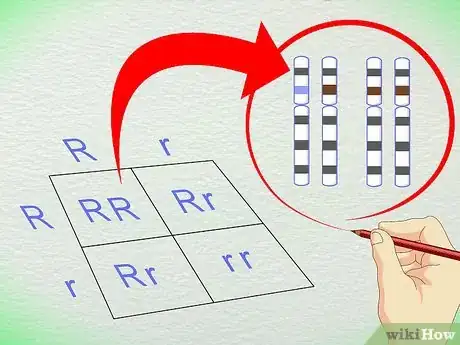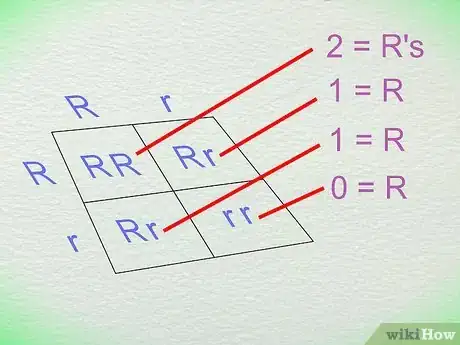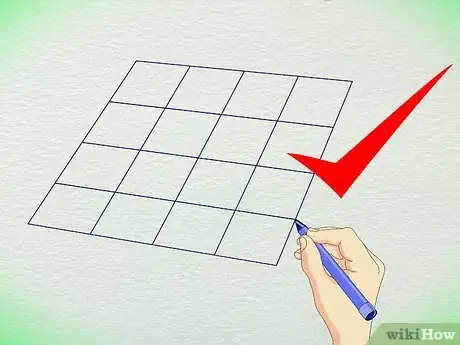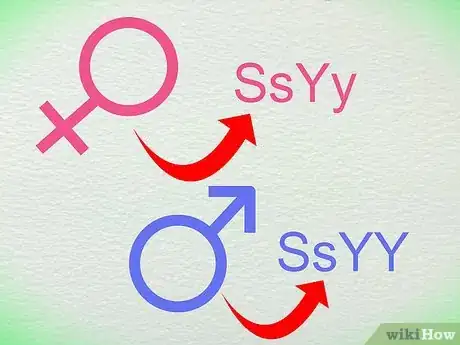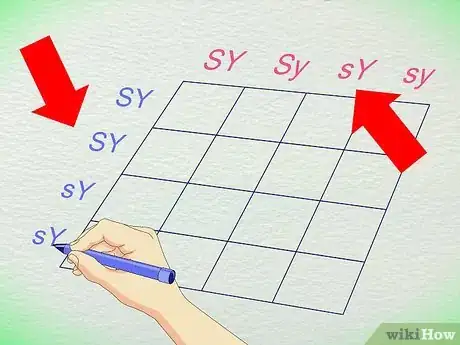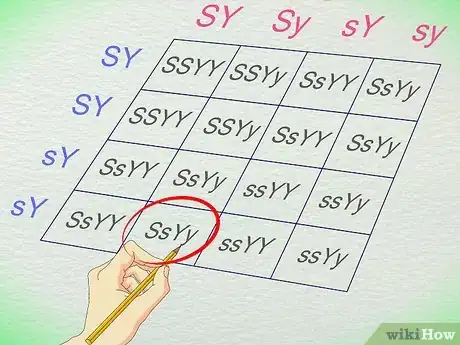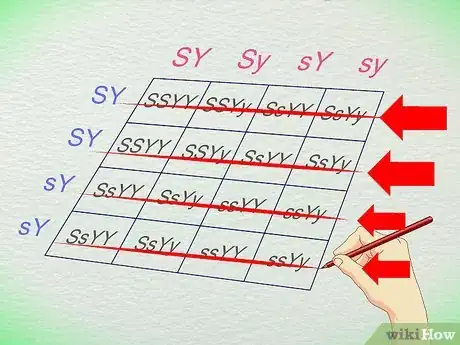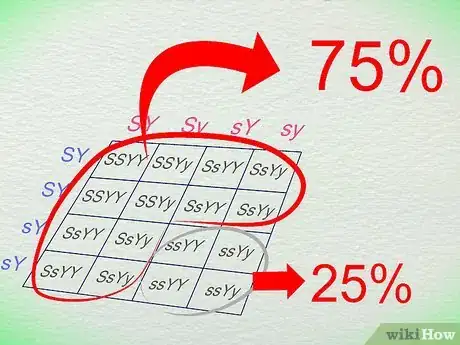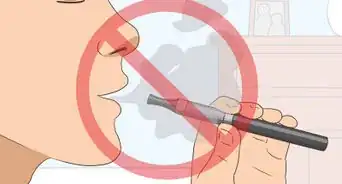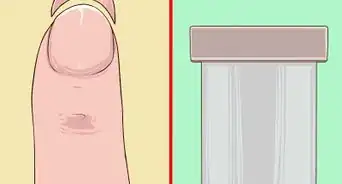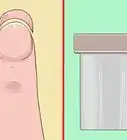wikiHow is a “wiki,” similar to Wikipedia, which means that many of our articles are co-written by multiple authors. To create this article, 24 people, some anonymous, worked to edit and improve it over time.
This article has been viewed 93,671 times.
Learn more...
Punnett Squares are visual tools used in the science of genetics to determine the possible combinations of genes that will occur at fertilization. A Punnett square is made of a simple square grid divided into 2x2 (or more) spaces. With this grid and knowledge of both parents' genotypes, scientists can discover the potential gene combinations for the offspring and even the chances of exhibiting certain inherited traits.
Steps
Before You Begin: Important Definitions
To skip this "basics" section and go straight to the Punnett square usage steps, click here.
-
1Understand the concept of genes. Before learning how to make and use Punnett squares, it's necessary to get some important basics out of the way. The first is the idea that all living things (from tiny microbes to giant blue whales) have genes. Genes are incredibly complex, microscopic sets of instructions encoded into almost every single cell in an organism's body. Genes are responsible, in some way, for virtually every aspect of an organism's life, including the way it looks, the way it behaves, and much, much more.
- One concept that's important to understand when working with Punnett squares is that living things get their genes from their parents.[1] You are probably already aware of this subconsciously. Think — don't the people you know seem to be similar to their parents in the way they look and act, generally?
-
2Understand the concept of sexual reproduction. Most (but not all) of the organisms you are aware of in the world around you make children via sexual reproduction. That is, a female parent and a male parent each contribute their genes to make a child with about half of its genes from each parent. A Punnett square is basically a way of showing the different possibilities that can occur from this half-and-half exchange of genes in the form of a graph.
- Sexual reproduction isn't the only form of reproduction out there. Some organisms (like many strains of bacteria) reproduce via asexual reproduction, which is when one parent makes a child all by itself. In asexual reproduction, all of the child's genes come from one parent, so the child is more or less a copy of its parent.
Advertisement -
3Understand the concept of alleles. As mentioned above, an organism's genes are basically a set of instructions that tell every cell in the organism's body how to live. In fact, just like an instruction manual is divided into different chapters, sections, and subsections, different parts of an organism's genes tell it how to do different things. If one of these "subsections" is different between two organisms, the two organisms may look or behave differently — for instance, genetic differences may lead one person to have black hair and another to have blonde hair. These different forms of the same gene are called alleles.
- Because a child gets two sets of genes — one from each parent — it will have two copies of every allele.
-
4Understand the concept of dominant and recessive alleles. A child's alleles do not always "share" their genetic power. Some alleles, called dominant alleles, will manifest in the child's looks and behavior (we call this "being expressed") by default. Others, called recessive alleles, will only be expressed if they're not paired with a dominant allele which can "override" them. Punnett squares are often used to help determine how likely a child is to receive a dominant or recessive allele.
- Because they can be "overridden" by dominant alleles, recessive alleles tend to be expressed more rarely. In general, a child will have to get a recessive allele from both parents for the allele to be expressed. A blood condition called sickle-cell anemia is a frequently-used example of a recessive trait — note, however, that recessive alleles aren't "bad" by definition.[2]
Showing a Monohybrid Cross (One Gene)
-
1Make a 2x2 square grid. The most basic Punnett squares are quite simple to set up. Begin by drawing a good-sized square, then dividing that square into four even boxes. When you're done, there should be two squares in each column and two squares in each row.
-
2Use letters to represent the parent alleles for each row and column. On a Punnett square, columns are assigned to the mother and the rows to the father, or vice versa. Write a letter next to each row and column that represents each of the mother's and father's alleles. Use capital letters for dominant alleles and lowercase for recessive alleles.
- This is much easier to understand with an example. For instance, let's say you want to determine the odds that a couple's child will be able to roll its tongue. We can represent this with the letters R and r — uppercase for the dominant gene and lowercase for the recessive. If both parents are heterozygous (have one copy of each allele), we would write one "R" and one "r" along the top of the grid and one "R" and one "r" along the left side of the grid.
-
3Write the letters for each space's row and column. Once you've figured out the alleles that each parent is contributing, filling in your Punnett square is easy. In each square, write the two-letter gene combination given from the mother and father's alleles. In other words, take the letter from the space's column and the letter from its row and write them together inside the space.
- In our example, we would fill in our squares like this:
- Top left square: RR
- Top right square: Rr
- Bottom left square: Rr
- Bottom right square: rr
- Notice that, traditionally, dominant alleles (capital letters) are written first.
-
4Determine each potential offspring's genotype. Each square of a filled-in Punnett square represents an offspring that the two parents can have. Every square (and thus every offspring) is equally likely — in other words, on a 2x2 grid, there is a 1/4 possibility for any of the four possibilities. The different combinations of alleles represented on a Punnett square are called genotypes. Though genotypes represent genetic differences, the offspring won't necessarily turn out differently for each square (see step below.)
- In our example Punnett square, the genotypes that are possible for an offspring from these two parents are:
- Two dominant alleles (from the two Rs)
- One dominant allele and one recessive (from the R and r)
- One dominant allele and one recessive (from the R and r) — notice that there are two squares with this genotype
- Two recessive allele (from the two rs)
-
5Determine each potential offspring's phenotype. An organism's phenotype is the actual physical trait that it displays based on its genotype. Just a few examples of phenotypes include eye color, hair color, and presence of sickle cell anemia — all of these are physical traits determined by genes, but none are the actual gene combinations themselves. The phenotype a potential offspring will have is determined by the characteristics of the gene. Different genes will have different rules for how they manifest as phenotypes.
- In our example, let's say that the gene that allows someone to roll their tongue is dominant. This means that any offspring will be able to roll their tongue even if only one of their alleles is dominant. In this case, the phenotypes of the potential offspring are:
- Top left: Can roll tongue (two Rs)
- Top right: Can roll tongue (one R)
- Bottom left: Can roll tongue (one R)
- Bottom right: Cannot roll tongue (zero Rs)
-
6Use the squares to determine the probability of different phenotypes. One of the most common uses for Punnett squares is to determine how likely it is that offspring will have specific phenotypes. Since each square represents an equally-likely genotype outcome, you can find a phenotype's likelihood by dividing the number of squares with that phenotype by the total number of squares.
- Our example Punnett square tells us that there are four possible gene combinations for any offspring from these parents. Three of these combinations make an offspring that can roll its tongue, while one does not. Thus, the probabilities for our two phenotypes are:
- Offspring can roll its tongue: 3/4 = 0.75 = 75%
- Offspring cannot roll its tongue: 1/4 = 0.25 = 25%
Showing a Dihybrid Cross (Two Genes)
-
1Double each side of the basic 2x2 grid for each additional gene. Not all gene combinations are as simple as the basic monohybrid (one-gene) cross from the section above. Some phenotypes are determined by more than one gene. In these cases, you must account for every possible combination, which means drawing a bigger grid.
- The basic rule for Punnett squares when it comes to more than one gene is this: double each side of the grid for each gene beyond the first. In other words, since a one-gene grid is 2x2, a two-gene grid is 4x4, a three-gene grid is 8x8, and so on.
- To make these concepts easier to understand, let's follow along with a two-gene example problem. This means we should draw a 4x4 grid. The concepts in this section hold true for three or more genes as well — these problems just require larger grids and more work.
-
2Determine the parents' genes being contributed. Next, find the genes that both parents have for the characteristic you're examining. Since you're dealing with multiple genes, each parent's genotype will have an additional two letters for each gene beyond the first — in other words, four letters for two genes, six letters for three genes, and so on. It can be helpful to write the mother's genotype above the top of the grid and the father's to the left (or vice versa) as a visual reminder.
- Let's use a classic example problem to illustrate these conflicts. A pea plant can have peas that are either smooth or wrinkled and yellow or green. Smooth and yellow are the dominant traits.[3] In this case, use S and s to represent dominant and recessive genes for smoothness and Y and y for yellowness. Let's say that the mother in this case has an SsYy genotype and the father has an SsYY genotype.
-
3Write the different gene combinations along the top and left sides. Now, above the top row of squares in the grid and to the left of the leftmost column, write the different alleles that can potentially be contributed by each parent. As when dealing with one gene, each allele is equally likely to be passed on. However, since you are looking at multiple genes, each row and column will get multiple letters: two letters for two genes, three letters for three genes, and so on.
- In our example, we need to write down the different combinations of genes that each parent can contribute from their SsYy genotypes. If we have the mother's SsYy genes across the top and the father's SsYY genes on the left, the alleles for each gene are:
- Across the top: SY, Sy, sY, sy
- Down the left side: SY, SY, sY, sY
-
4Fill in the spaces with each combination of alleles. Fill in the spaces in the grid just as you would when dealing with a single gene. However, this time, each space will have two extra additional letters for each gene beyond the first: four letters for two genes, six letters for three genes. As a general rule, the number of letters in each space should match the number of letters in each parent's genotype.
- In our example, we would fill in our spaces like this:
- Top row: SSYY, SSYy, SsYY, SsYy
- Second row: SSYY, SSYy, SsYY, SsYy
- Third row: SsYY, SsYy, ssYY, ssYy
- Bottom row: SsYY, SsYy, ssYY, ssYy
-
5Find the phenotypes for each potential offspring. When dealing with multiple genes, each space in the Punnett square still represents the genotype for each potential offspring — there are just a greater number of choices than there are with one gene. The phenotypes for each square are, once again, dependent on the exact genes being dealt with. However, as a general rule, dominant traits need only one dominant allele to be expressed, while recessive traits need all recessive alleles.[4]
- In our example, since smoothness and yellowness are dominant traits for our peas, any square with at least one capital S represents a plant with a smooth phenotype and any square with at least one capital Y represents a plant with a yellow phenotype. Wrinkled plants need two lowercase s alleles and green plants need two lowercase ys. From these conditions, we get:
- Top row: Smooth/yellow, Smooth/yellow, Smooth/yellow, Smooth/yellow
- Second row: Smooth/yellow, Smooth/yellow, Smooth/yellow, Smooth/yellow
- Third row: Smooth/yellow, Smooth/yellow, wrinkled/yellow, wrinkled/yellow
- Bottom row: Smooth/yellow, Smooth/yellow, wrinkled/yellow, wrinkled/yellow
-
6Use the squares to determine the likelihood of each phenotype. Use the same techniques as when dealing with one gene to find the likelihood that any offspring from the two parents can have each different phenotype. In other words, the number of squares with the phenotype divided by the total number of squares equals the probability for each phenotype.
- In our example, the probabilities for each phenotype are:
- Offspring is smooth and yellow: 12/16 = 3/4 = 0.75 = 75%
- Offspring is wrinkled and yellow: 4/16 = 1/4 = 0.25 = 25%
- Offspring is smooth and green: 0/16 = 0%
- Offspring is wrinkled and green: 0/16 = 0%
- Notice that since it is impossible for any offspring to get two recessive y alleles, none of the offspring will be green.
Warnings
- Beware — each new parent gene you add to the Punnett square causes each of the grid's sides to double in length. For example, with one gene from each parent, you will have a 2x2 Punnett square, with two genes, a 4x4 square, and so on. At five genes, you will have a massive 32x32 square!⧼thumbs_response⧽
References
- ↑ http://www.nlm.nih.gov/exhibition/harrypottersworld/pdf/teachersgeneticterms.pdf
- ↑ http://learn.genetics.utah.edu/content/inheritance/patterns/
- ↑ http://www.biology.arizona.edu/mendelian_genetics/problem_sets/dihybrid_cross/03t.html
- ↑ http://www.biology.arizona.edu/mendelian_genetics/problem_sets/dihybrid_cross/03t.html
- ↑ http://scienceprimer.com/punnett-square-calculator
- ↑ http://www.cdc.gov/malaria/about/biology/sickle_cell.html
